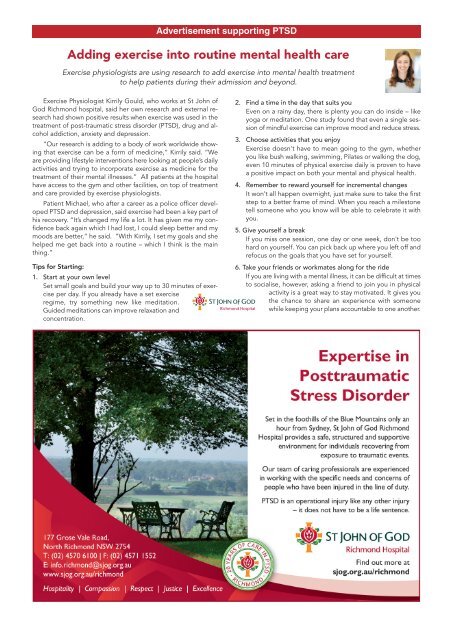Create successful ePaper yourself
Turn your PDF publications into a flip-book with our unique Google optimized e-Paper software.
Advertisement supporting PTSD<br />
Adding exercise into routine mental health care<br />
Exercise physiologists are using research to add exercise into mental health treatment<br />
to help patients during their admission and beyond.<br />
Exercise Physiologist Kirrily Gould, who works at St John of<br />
God Richmond hospital, said her own research and external research<br />
had shown positive results when exercise was used in the<br />
treatment of post-traumatic stress disorder (PTSD), drug and alcohol<br />
addiction, anxiety and depression.<br />
“Our research is adding to a body of work worldwide showing<br />
that exercise can be a form of medicine,” Kirrily said. “We<br />
are providing lifestyle interventions here looking at people’s daily<br />
activities and trying to incorporate exercise as medicine for the<br />
treatment of their mental illnesses.” All patients at the hospital<br />
have access to the gym and other facilities, on top of treatment<br />
and care provided by exercise physiologists.<br />
Patient Michael, who after a career as a police officer developed<br />
PTSD and depression, said exercise had been a key part of<br />
his recovery. “It’s changed my life a lot. It has given me my confidence<br />
back again which I had lost, I could sleep better and my<br />
moods are better,” he said. “With Kirrily, I set my goals and she<br />
helped me get back into a routine – which I think is the main<br />
thing.”<br />
Tips for Starting:<br />
1. Start at your own level<br />
Set small goals and build your way up to 30 minutes of exercise<br />
per day. If you already have a set exercise<br />
regime, try something new like meditation.<br />
Guided meditations can improve relaxation and<br />
concentration.<br />
2. Find a time in the day that suits you<br />
Even on a rainy day, there is plenty you can do inside – like<br />
yoga or meditation. One study found that even a single session<br />
of mindful exercise can improve mood and reduce stress.<br />
3. Choose activities that you enjoy<br />
Exercise doesn't have to mean going to the gym, whether<br />
you like bush walking, swimming, Pilates or walking the dog,<br />
even 10 minutes of physical exercise daily is proven to have<br />
a positive impact on both your mental and physical health.<br />
4. Remember to reward yourself for incremental changes<br />
It won’t all happen overnight, just make sure to take the first<br />
step to a better frame of mind. When you reach a milestone<br />
tell someone who you know will be able to celebrate it with<br />
you.<br />
5. Give yourself a break<br />
If you miss one session, one day or one week, don't be too<br />
hard on yourself. You can pick back up where you left off and<br />
refocus on the goals that you have set for yourself.<br />
6. Take your friends or workmates along for the ride<br />
If you are living with a mental illness, it can be difficult at times<br />
to socialise, however, asking a friend to join you in physical<br />
activity is a great way to stay motivated. It gives you<br />
the chance to share an experience with someone<br />
while keeping your plans accountable to one another.

















